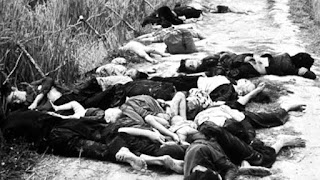The My Lai massacre
The My Lai massacre was one of the most horrific incidents of violence committed during the Vietnam War.
A company of American soldiers brutally killed most of the people—women, children and old men—in the village of My Lai on March 16, 1968. More than 500 people were slaughtered in the My Lai massacre, including young girls and women who were raped and mutilated before being killed.
U.S. Army officers covered up the carnage for a year before it was reported in the American press, sparking a firestorm of international outrage. The brutality of the My Lai massacre and the official cover-up fueled anti-war sentiment and further divided the United States over the Vietnam War.
In March 1968, Charlie Company—part of the Americal Division’s 11th Infantry Brigade—received word that VC guerrillas had taken control of the neighboring village of Son My. Charlie Company was sent to the area on March 16 for a search-and-destroy mission.
At the time, morale among U.S. soldiers on the ground was dwindling, especially in the wake of the North Vietnamese-led Tet Offensive, which was launched in January 1968. Charlie Company had lost some 28 of its members to death or injuries, and was down to just over 100 men.
William Calley
Army commanders had advised the soldiers of Charlie Company that all who were found in the Son My area could be considered VC or active VC sympathizers, and ordered them to destroy the village.
When they arrived shortly after dawn, the soldiers—led by Lieutenant William Calley—found no Viet Cong. Instead, they came across a quiet village of primarily women, children and older men preparing their breakfast rice.
The villagers were rounded up into groups as the soldiers inspected their huts. Despite finding only a few weapons, Calley ordered his men to begin shooting the villagers.
My Lai Massacre Begins
Some soldiers balked at Calley’s command, but within seconds the massacre had begun, with Calley himself shooting numerous men, women and children.
Mothers who were shielding their children were shot, and when their children tried to run away, they too were slaughtered. Huts were set on fire, and anyone inside who tried to escape was gunned down.
“I saw them shoot an M79 (grenade launcher) into a group of people who were still alive. But it was mostly done with a machine gun. They were shooting women and children just like anybody else,” Sgt. Michael Bernhardt, a soldier at the scene, later told a reporter.
“We met no resistance and I only saw three captured weapons. We had no casualties. It was just like any other Vietnamese village—old papa-sans [men], women and kids. As a matter of fact, I don’t remember seeing one military-age male in the entire place, dead or alive,” Bernhardt said.
In addition to killing unarmed men, women and children, the soldiers slaughtered countless livestock, raped an unknown number of women, and burned the village to the ground.
Calley was reported to have dragged dozens of people, including young children, into a ditch before executing them with a machine gun. Not a single shot was fired against the men of Charlie Company at My Lai.
Hugh Thompson
The My Lai massacre reportedly ended only after Warrant Officer Hugh Thompson, an Army helicopter pilot on a reconnaissance mission, landed his aircraft between the soldiers and the retreating villagers and threatened to open fire if they continued their attacks.
“We kept flying back and forth … and it didn’t take very long until we started noticing the large number of bodies everywhere. Everywhere we’d look, we’d see bodies.
These were infants, two- three-, four-, five-year-olds, women, very old men, no draft-age people whatsoever,” Thompson stated at a My Lai conference at Tulane University in 1994.
Thompson and his crew flew dozens of survivors to receive medical care. In 1998, Thompson and two other members of his crew received the Soldier’s Medal, the U.S. Army’s highest award for bravery not involving direct contact with the enemy.





.jpg)

.jpeg)






Comments
Post a Comment